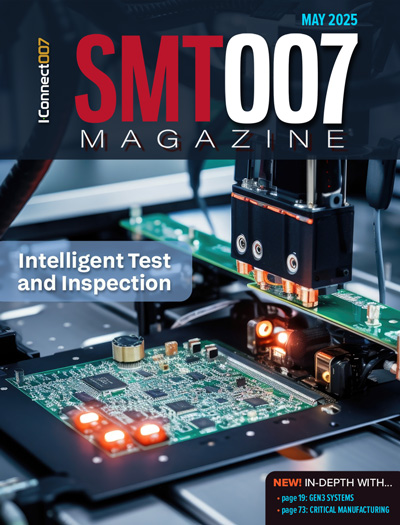-

-
News
News Highlights
- Books
Featured Books
- smt007 Magazine
Latest Issues
Current Issue
What's Your Sweet Spot?
Are you in a niche that’s growing or shrinking? Is it time to reassess and refocus? We spotlight companies thriving by redefining or reinforcing their niche. What are their insights?

Moving Forward With Confidence
In this issue, we focus on sales and quoting, workforce training, new IPC leadership in the U.S. and Canada, the effects of tariffs, CFX standards, and much more—all designed to provide perspective as you move through the cloud bank of today's shifting economic market.

Intelligent Test and Inspection
Are you ready to explore the cutting-edge advancements shaping the electronics manufacturing industry? The May 2025 issue of SMT007 Magazine is packed with insights, innovations, and expert perspectives that you won’t want to miss.
- Articles
- Columns
- Links
- Media kit
||| MENU - smt007 Magazine
Study: How Should Backing for Clean Technology be Designed?
January 21, 2016 | MITEstimated reading time: 4 minutes
Uncertain demand for new technologies might seem to help boost sales; firms would likely want to produce enough goods to meet potential demand, while also keeping prices low enough to spur further adoption. But that isn’t the only mechanism at work. Firms always worry about having unsold inventory, and a certain number of early-adopting technology consumers seem willing to pay high prices. Those additional factors mean firms also have reason to aim for relatively high prices, while producing relatively modest quantities of the new product.
That’s where subsidy levels matter. Suppose the market for solar panels was predictable, with a similar number of arrays being sold every month. With a given subsidy, firms would know how much to produce and how much to charge consumers. But demand for clean-tech innovations isn’t steady. For some electric vehicles and other products, sales have started off slowly before curving upward.
For those cases, after studying the demand data and modeling a variety of scenarios with different subsidy levels, the researchers came to the conclusion that subsidy levels often start off too low. For the Chevy Volt, for instance, the optimal subsidy should have been higher relative to the $7,500 offered by the U.S. government, the researchers concluded.
That estimation varies depending on the sales target as well as the uncertainty in terms of the sales: To get 2,000 Volts sold faster, they found, the subsidy level should have been much higher. But to reach, say, 10,000 Volts sold, the subsidy would not need to be five times as high as that needed to sell 2,000 cars; the modeling shows the needed subsidy increases in a curve that tapers off as the sales volume grows.
At any level of sales, the higher subsidy helps keep firms from reacting to demand uncertainty by aiming for higher prices along with more modest sales. And higher subsidies are particularly crucial in the early stages of a clean-technology product launch.
In general, as the researchers write in the paper, ignoring the uncertain nature of consumer demand when setting subsidies means “sales can be significantly below the desired adoption target level.”
“Important and timely”
The new paper is part of a larger program of study in which Perakis and Cohen, working with Charles Thraves, a PhD student at the MIT Operations Research Center, have studied the impact of competition in green technology markets. In particular, they investigate how the growing number of competitors in the electric vehicle industry affects the subsidy level offered to consumers.
The results stem from a model the scholars have developed that uses data from the transportation and home-energy sectors while also representing many aspects of consumer choice in the green-technology marketplace.
That model also allows the researchers to explore whether or not clean-technology subsidies pay for themselves in the larger context. They do, the results show, when one includes “externalities” such as costly environmental damage.
“The conclusion that we drew is that basically if the government sets subsidies ‘the right way,’ taking externalities into account, [then consumers] will not do badly,” Perakis says. “Even if there are big externalities.”
Other scholars say the research program and the latest paper are valuable. Ozalp Ozer, a professor of management science at the University of Texas at Dallas, who has read the paper, says it “addresses a very important and timely problem” and that “policy makers should pay close attention” to the research framework, since it “highlights some of the shortcomings of current subsidy practices.”
The research was supported, in part, by the MIT Energy Initiative.
Suggested Items
Microchip Enters into Partnership Agreement with Delta Electronics on Silicon Carbide Solutions
07/18/2025 | Globe NewswireThe growth of artificial intelligence (AI) and the electrification of everything are driving an ever-increasing demand for higher levels of power efficiency and reliability.
ViTrox’s HITS 5.0 Empowers Global Partners with Innovative Solutions and Stronger Bonds
07/16/2025 | ViTroxViTrox, strives to be the World’s Most Trusted Technology Company, proudly announces the successful conclusion of its fifth edition of High Impact Training for Sales (HITS 5.0), held from 23rd to 27th June 2025 at ViTrox Campus 2.0 and 3.0, located in Batu Kawan Industrial Park, Penang, Malaysia.
Global Citizenship: The Global Push for Digital Inclusion
07/16/2025 | Tom Yang -- Column: Global CitizenshipIt can be too easy to take the technology at our fingertips for granted: high-speed internet, cloud-based collaboration, and instant video calls across continents. Yet, for billions of people, access to these digital tools is a distant dream. As a global community, we must ensure that technology is available to all. Here is how technology is bridging physical, economic, and educational gaps in underserved regions and profoundly reshaping lives.
Microchip Expands Space-Qualified FPGA Portfolio with New RT PolarFire® Device Qualifications and SoC Availability
07/10/2025 | MicrochipContinuing to support the evolving needs of space system developers, Microchip Technology has announced two new milestones for its Radiation-Tolerant (RT) PolarFire® technology: MIL-STD-883 Class B and QML Class Q qualification of the RT PolarFire RTPF500ZT FPGA and availability of engineering samples for the RT PolarFire System-on-Chip (SoC) FPGA.
Infineon Advances on 300-millimeter GaN Manufacturing Roadmap as Leading Integrated Device Manufacturer (IDM)
07/10/2025 | InfineonAs the demand for gallium nitride (GaN) semiconductors continues to grow, Infineon Technologies AG is poised to capitalize on this trend and solidify its position as a leading Integrated Device Manufacturer (IDM) in the GaN market.


